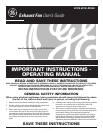
210572118 Rev. B 5-06
GENERAL SAFETY INFORMATION
(Continued)
CAUTION: FOR GENERAL VENTILATING USE ONLY. DO NOT
USE TO EXHAUST HAZARDOUS OR EXPLOSIVE MATERIALS AND
VAPORS.
6. When cutting or drilling into wall or ceiling, do not damage electrical
wiring and other hidden utilities.
7. Ducted fans must always be vented to the outdoors.
8. This unit must be grounded.
9. To avoid motor bearing damage and noisy and/or unbalanced
impellers, keep drywall spray, construction dust, etc. off power unit.
WARNING: TO REDUCE THE RISK OF FIRE, ELECTRIC SHOCK,
DO NOT USE THIS FAN WITH ANY SOLID-STATE SPEED CONTROL DEVICE.
10. Acceptable for use over a bathtub or shower when installed in a
GFCI protected branch circuit.
11. NEVER place a switch where it can be reached from a tub or shower.
WARNING: DO NOT USE IN KITCHENS
INSTALLATION INSTRUCTIONS
CAUTION:
MAKE SURE POWER IS SWITCHED OFF AT SERVICE
PANEL BEFORE STARTING INSTALLATION.
SECTION 1
Preparing the Exhaust Fan
1. Unpack fan from the carton and confirm that all pieces are present.
In addition to the exhaust fan you should have:
1 - Grill
4 - Mounting Rails
1 - Damper Assembly (attached)
1 - Instruction/Safety Sheet
2. Remove the fan’s venturi assembly, which is secured in place with
one screw through the venturi (Figure 1). This is a captive screw and
will stay installed in the venturi. Keep the venturi assembly and the
grill in the carton until needed so they do not get damaged or lost.
3. Choose the location for your fan. To ensure the best air and sound
performance, it is recommended that the length of ducting and
the number of elbows be kept to a minimum, and that insulated
hard ducting be used. Larger duct sizes will reduce noise and
airflow restrictions. This fan will require at least 6" of clearance
in the ceiling or wall, and will mount through drywall up to 3/4"
thick. The fan mounts to the joist using the mounting tabs on the
side of the housing or between 16" or 24" on center joists using
the 4 provided mounting rails.
Figure 2
4. Select the most convenient electrical
knockout and remove using a straight-
blade screw driver (Figure 2).
SECTION 2
New Construction
1. Install the mounting rails on the housing and position the housing
next to the joist. Line up housing so that it will be flush with the
finished ceiling. Secure the ends of the rails with screws or nails
(not included) to the joists and slide the housing into the final
position (Figure 3).
SECTION 3
Existing Construction
1. Set housing in position between the joist and trace an outline onto
the ceiling material (Figure 4). Set housing aside and cut opening,
being careful not to cut or damage any electrical or other hidden
utilities. Install the rails on the housing and position the housing
in the previously cut hole so that it is flush with the finished ceiling.
Secure the ends of the rails to the joists (Figure 3).
SECTION 4
Ducting
CAUTION: ALL DUCTING MUST COMPLY WITH LOCAL AND
NATIONAL BUILDING CODES.
1. Connect the ducting to the fan’s duct collar (Figure 5). Secure in
place using tape or screw clamp. Always duct the fan to the
outside through a wall or roof cap.
Figure 1
Figure 3
Joist
Housing
Mounting Rails
Figure 4
Joist
2 of 4
www.geelectrical.com






